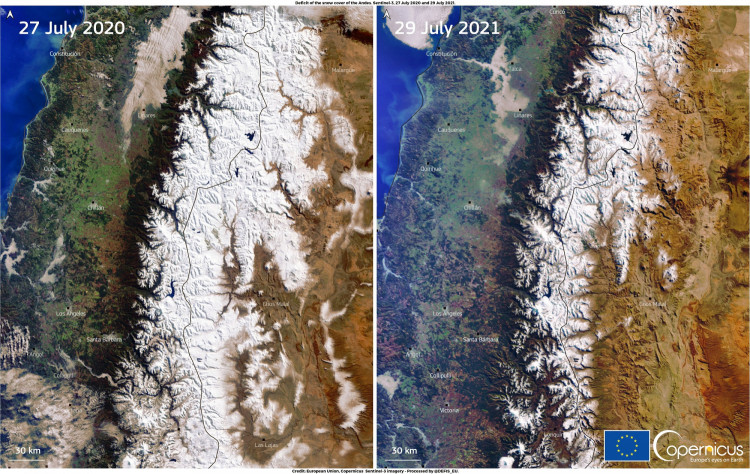The Copernicus Sentinel-3 satellite of the European Union has released satellite images of a "mega-drought" and snow shortage in the Andes mountain range, which attracts skiers to South America.
Global warming has been linked to this year's extremely low snowfall during a decade-long drought, according to scientists.
Communities that rely on the mountains for water supply are likely to face shortages as precipitation drops and glaciers retreat across the region, according to Ricardo Villalba, principal investigator for the Argentine Institute of Snow, Glacier, and Environment Science Studies (IANIGLA).
Snow cover has decreased dramatically between July 2020 and this year, according to satellite images. This is mirrored in river water level readings. The glaciers of the Andes, which had kept the same size or even grown in size between 2000 and 2010, were suddenly receding.
Caused by a scarcity of snowfall and rain, many of the magnificent mountains between Argentina and Ecuador and Argentina have patchy snow cover or no snow at all, displaying barren brown ground.
Ski resorts have reopened and are bringing ecstatic skiers to the Argentina-Chile border after long closures due to the pandemic. However, due to a lack of snowfall, many resorts are forced to move snow to cover popular runs or create artificial snow.
According to Etienne Berthier, a glaciologist at the Laboratory of Geophysical Studies and Oceanography in Toulouse, France, glaciers have lost roughly 3 feet in thickness annually over the Andes since 2000. His findings were published in Nature Geoscience.
Warming temperatures have also led glaciers to retreat quickly, especially in the southern Andes, where some have retreated 5.5 miles in the last century. This century, 98% of Andean glaciers have shrunk.
Glacier meltwater is used for drinking, irrigation, and hydroelectric generation in communities in and around the Andes, especially in drylands and during droughts.
Until recently, data on the speed and volume of Andean ice loss was limited to more easily accessible locations, with scientists manually putting stakes in glaciers and monitoring changes in mass over time.
However, modern satellite studies have greatly increased scientists' ability to track melting glaciers in the Andes and throughout the world.






